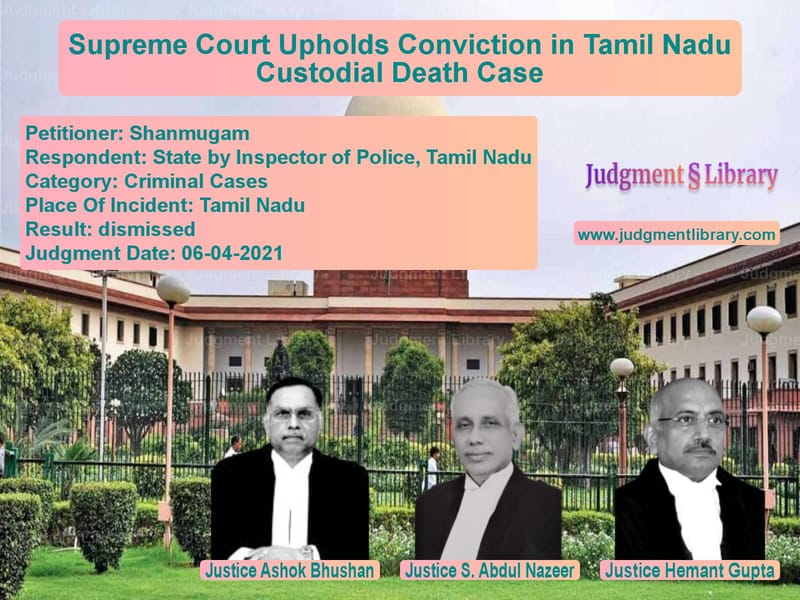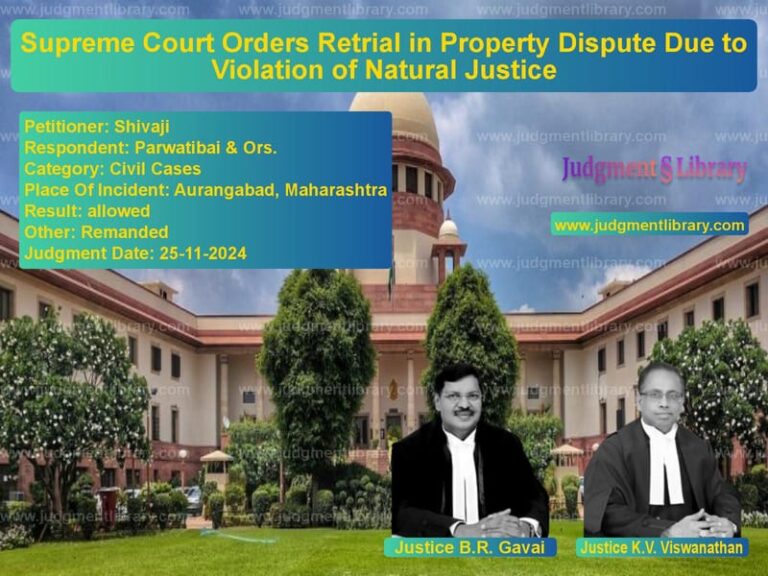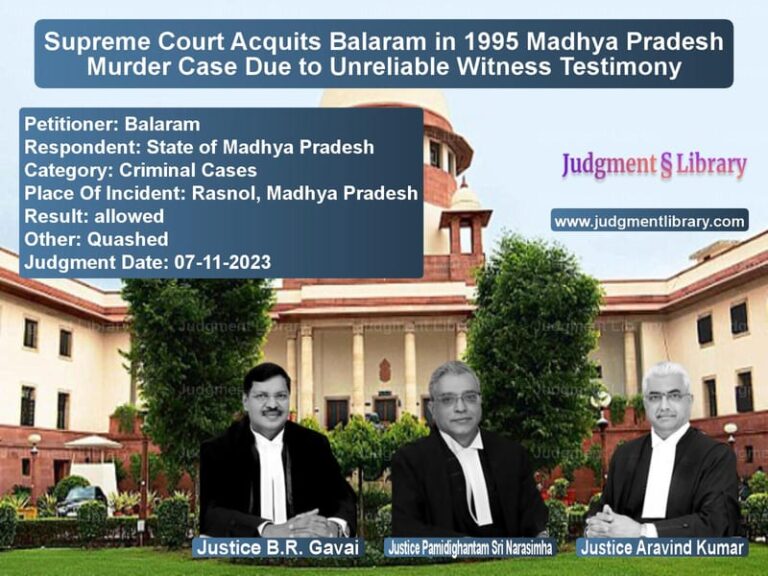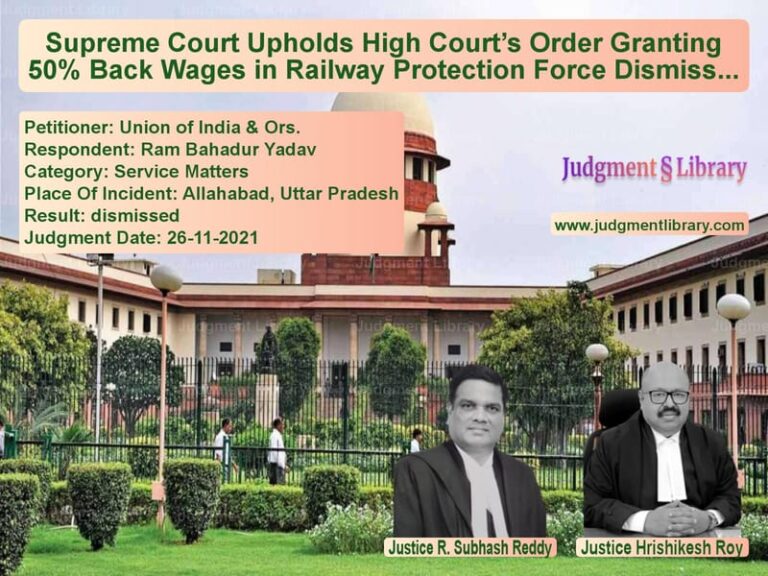Supreme Court Upholds Conviction in Tamil Nadu Custodial Death Case
The Supreme Court of India, in the case of Shanmugam v. State by Inspector of Police, Tamil Nadu, upheld the conviction of the appellant for the murder of a Head Constable inside a police station. The ruling reaffirmed the principle that a complete chain of circumstantial evidence can establish guilt beyond a reasonable doubt in cases lacking direct eyewitness testimony.
Background of the Case
The case arose from an incident on September 10, 2005, when the accused, Shanmugam, attempted to escape police custody by attacking Head Constable Kaliappan with an iron stool, causing his death. Shanmugam had been arrested the previous night by the Video Piracy Cell of Tamil Nadu Police on charges under the Copyright Act, 1957, for allegedly possessing and distributing pirated videos.
Following the attack, Shanmugam was apprehended while trying to escape. A charge sheet was filed against him under Section 302 (Murder) and Section 224 read with Section 511 of the Indian Penal Code (IPC). The Additional Sessions Judge, Fast Track Court No. II, Coimbatore, convicted him and sentenced him to life imprisonment with an additional one-year sentence for the attempted escape. The conviction was later upheld by the Madras High Court.
Key Issues Raised
- Whether the prosecution successfully proved the accused’s guilt beyond a reasonable doubt.
- Whether circumstantial evidence was sufficient to uphold the conviction.
- Whether procedural lapses in the investigation affected the case.
Arguments by the Appellant (Shanmugam)
- “The prosecution’s case is entirely based on circumstantial evidence, and no eyewitness directly saw me commit the crime.”
- “The deceased was found dead inside the police station, but the evidence presented does not conclusively prove that I was responsible.”
- “There were procedural lapses, including the failure to include the police station’s premises in the rough sketch (Exhibit P-22).”
Arguments by the Respondent (State of Tamil Nadu)
- “The accused was last seen with the deceased inside the police station, and no other individual had access to the locked room where the incident occurred.”
- “Multiple police officers testified that when they opened the locked room, the accused attempted to escape, confirming his involvement in the crime.”
- “The accused made a false call to the police control room using the deceased’s mobile phone to create an alibi, which was proven by forensic analysis.”
Supreme Court’s Observations and Ruling
1. Circumstantial Evidence Establishing Guilt
- “The accused was the last person seen with the deceased, and no one else had access to the premises, making him the prime suspect.”
- “The accused’s attempt to escape and his false control room call reinforce his guilt beyond a reasonable doubt.”
2. Evaluation of Procedural Lapses
- “The absence of a police station sketch in the investigation report is a minor irregularity that does not affect the case’s core facts.”
- “The testimonies of prosecution witnesses (PW-1, PW-2, PW-6, and PW-9) were consistent and corroborated each other, proving the sequence of events.”
3. Chain of Events Proved Beyond Doubt
- “The forensic evidence confirmed that the fatal blow was inflicted by the accused using an iron stool found at the crime scene.”
- “The accused’s call to the control room using the deceased’s phone was a deliberate attempt to mislead investigators.”
Supreme Court’s Judgment
The Supreme Court ruled as follows:
- The conviction under Section 302 IPC (murder) and Section 224 r/w 511 IPC (attempted escape) is upheld.
- The sentence of life imprisonment and additional one-year imprisonment for attempted escape remains unchanged.
- The appeal is dismissed, and the judgment of the Madras High Court in Crl. Appeal No. 508 of 2007 is confirmed.
Key Takeaways from the Judgment
- Circumstantial evidence can be conclusive: The Supreme Court reaffirmed that a well-established chain of circumstantial evidence is sufficient for conviction.
- Last-seen theory is valid in custodial cases: The fact that the accused was last seen with the deceased and had exclusive access to the crime scene was critical in proving guilt.
- Minor procedural lapses do not vitiate a case: While some investigation flaws existed, they did not weaken the core findings of the prosecution.
- False defense strengthens the prosecution’s case: The accused’s misleading phone call was seen as a deliberate effort to obstruct justice.
Conclusion
The Supreme Court’s ruling in Shanmugam v. State by Inspector of Police, Tamil Nadu reinforces the principle that circumstantial evidence, if well established, is as powerful as direct evidence in securing convictions. By upholding the lower courts’ findings, the Court ensured that custodial crimes do not go unpunished, thereby strengthening the rule of law.
Read also: https://judgmentlibrary.com/mukhtar-ansaris-custody-supreme-court-orders-transfer-to-uttar-pradesh/
Petitioner Name: Shanmugam.Respondent Name: State by Inspector of Police, Tamil Nadu.Judgment By: Justice Ashok Bhushan, Justice S. Abdul Nazeer, Justice Hemant Gupta.Place Of Incident: Tamil Nadu.Judgment Date: 06-04-2021.
Don’t miss out on the full details! Download the complete judgment in PDF format below and gain valuable insights instantly!
Download Judgment: shanmugam-vs-state-by-inspector-o-supreme-court-of-india-judgment-dated-06-04-2021.pdf
Directly Download Judgment: Directly download this Judgment
See all petitions in Custodial Deaths and Police Misconduct
See all petitions in Murder Cases
See all petitions in Judgment by Ashok Bhushan
See all petitions in Judgment by S. Abdul Nazeer
See all petitions in Judgment by Hemant Gupta
See all petitions in dismissed
See all petitions in supreme court of India judgments April 2021
See all petitions in 2021 judgments
See all posts in Criminal Cases Category
See all allowed petitions in Criminal Cases Category
See all Dismissed petitions in Criminal Cases Category
See all partially allowed petitions in Criminal Cases Category







